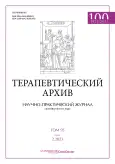Assessment of the possible impact of hepatitis viruses on the development and course of autoimmune liver diseases
- Authors: Sbikina E.S.1, Vinnitskaya E.V.1, Batskikh S.N.1, Sandler Y.G.1, Saliev K.G.1, Khaimenova T.Y.1, Bordin D.S.1,2,3
-
Affiliations:
- Loginov Moscow Clinical Scientific Center
- Yevdokimov Moscow State University of Medicine and Dentistry
- Tver State Medical University
- Issue: Vol 95, No 2 (2023)
- Pages: 173-178
- Section: Original articles
- URL: https://journals.rcsi.science/0040-3660/article/view/132902
- DOI: https://doi.org/10.26442/00403660.2023.02.202113
- ID: 132902
Cite item
Full Text
Abstract
Background. Despite the well-studied pathogenesis, the etiology of autoimmune liver disease (AILD) remains unknown.
Aim. To determine the significance of hepatitis A, B, C and E viruses in the development and progression of AILD.
Materials and methods. A single-center case-control study included 139 patients with AILD: autoimmune hepatitis – AIH (n=46), primary biliary cholangitis – PBS (n=74), primary sclerosing cholangitis – PSC (n=19). Median age 56 years, IQR 48–65 years. 125 patients – without liver disease – control group (median age 55 years, IQR 46–65 years). Testing of blood serum samples for anti-HAV IgG, anti-HEV IgG, HBsAg, anti-HBc IgG, anti-HCV was carried out by solid-phase ELISA. All patients underwent fibroelastography. Needle liver biopsy – 70 patients: AIH (n=37), PBC (n=28) and PSC (n=5).
Results. Ab(IgG) to HAV and HBV were detected in patients with AILD significantly more often than in the control group (74.8% vs 54.4%; p<0.001). An increased risk of developing AILD was established in patients with the presence of antibodies to HAV, HBV and HEV (OR 2.491, CI 95% [1.481–4.190]). The highest risk of developing PBC was found in patients with antibodies to HAV and HBV (OR 3.008, 95% CI [1.633–5.542] and OR 2.515, 95% CI [1.242–5.093]). In patients with severe liver fibrosis (F3–F4 according to METAVIR), antibodies to HAV and HBV were detected significantly more often than in patients with F0–F2 [85% vs 65%; p=0.008].
Conclusion. In our work, we have demonstrated the relationship of past hepatitis A, B, E and AILD, as well as the high risk of developing severe fibrosis in patients with AILD and markers of hepatitis A and B viruses indicates the possible involvement of these viruses in the pathogenesis of AILD.
Full Text
##article.viewOnOriginalSite##About the authors
Evgeniya S. Sbikina
Loginov Moscow Clinical Scientific Center
Author for correspondence.
Email: e.sbikina@mknc.ru
ORCID iD: 0000-0003-2195-9643
мл. науч. сотр. отд. гепатологии
Russian Federation, MoscowElena V. Vinnitskaya
Loginov Moscow Clinical Scientific Center
Email: e.sbikina@mknc.ru
ORCID iD: 0000-0002-0344-8375
д-р мед. наук, зав. отд. гепатологии
Russian Federation, MoscowSergey N. Batskikh
Loginov Moscow Clinical Scientific Center
Email: e.sbikina@mknc.ru
ORCID iD: 0000-0002-5917-203X
канд. мед. наук, ст. науч. сотр. отд. гепатологии
Russian Federation, MoscowYuliay G. Sandler
Loginov Moscow Clinical Scientific Center
Email: e.sbikina@mknc.ru
ORCID iD: 0000-0003-4291-812X
канд. мед. наук, ст. науч. сотр. отд. гепатологии
Russian Federation, MoscowKirill G. Saliev
Loginov Moscow Clinical Scientific Center
Email: e.sbikina@mknc.ru
ORCID iD: 0000-0002-4581-7052
мл. науч. сотр. отд. гепатологии
Russian Federation, MoscowTatyana Yu. Khaimenova
Loginov Moscow Clinical Scientific Center
Email: e.sbikina@mknc.ru
ORCID iD: 0000-0002-4599-4040
канд. мед. наук, зав. отд-нием хронических заболеваний печени
Russian Federation, MoscowDmitry S. Bordin
Loginov Moscow Clinical Scientific Center; Yevdokimov Moscow State University of Medicine and Dentistry; Tver State Medical University
Email: e.sbikina@mknc.ru
ORCID iD: 0000-0003-2815-3992
д-р мед. наук, зав. отд. патологии поджелудочной железы, желчных путей и верхних отделов пищеварительного тракта, проф. каф. пропедевтики внутренних болезней и гастроэнтерологии, проф. каф. общей врачебной практики и семейной медицины
Russian Federation, Moscow; Moscow; TverReferences
- Trivedi PJ, Hirschfield GM. Recent advances in clinical practice: epidemiology of autoimmune liver diseases. Gut. 2021;70(10):1989-2003. doi: 10.1136/gutjnl-2020-322362
- Lamba M, Ngu JH, Stedman CAM. Trends in Incidence of Autoimmune Liver Diseases and Increasing Incidence of Autoimmune Hepatitis. Clin Gastroenterol Hepatol. 2021;19(3):573-9.e1. doi: 10.1016/j.cgh.2020.05.061
- Razavi H. Global Epidemiology of Viral Hepatitis. Gastroenterol Clin North Am. 2020;49(2):179-89. doi: 10.1007/978-3-030-03535-8_1
- Михайлов М.И., Кюрегян К.К., Малинникова Е.Ю., и др. Вирусные гепатиты: прогнозы и проблемы. Эпидемиология и инфекционные болезни. Актуальные вопросы. 2019;1:71-80 [Mikhailov MI, Kyuregyan KK, Malinnikova EYu, et al. Viral hepatitis: forecasts and problems. Epidemiology and infectious diseases. Topical Issues. 2019;1:71-80 (in Russian)]. doi: 10.18565/epidem.2019.9.1.71-80
- Jefferies M, Rauff B, Rashid H, et al. Update on global epidemiology of viral hepatitis and preventive strategies. World J Clin Cases. 2018;6(13):589-99. doi: 10.12998/wjcc.v6.i13.589
- Kawashima M, Hitomi Y, Aiba Y, et al. Genome-wide association studies identify PRKCB as a novel genetic susceptibility locus for primary biliary cholangitis in the Japanese population. Hum Mol Genet. 2017;26(3):650-9. doi: 10.1093/hmg/ddw406
- Hilzenrat N, Zilberman D, Klein T, et al. Autoimmune hepatitis in a genetically susceptible patient: is it triggered by acute viral hepatitis A? Dig Dis Sci. 1999;44(10):1950-2. doi: 10.1023/a:1026645629103
- Rahaman SM, Chira P, Koff RS. Idiopathic autoimmune chronic hepatitis triggered by hepatitis A. Am J Gastroenterol. 1994;89:106-8.
- Singh G, Palaniappan S, Rotimi O, Hamlin PJ. Autoimmune hepatitis triggered by hepatitis A. Gut. 2007;56(2):304. doi: 10.1136/gut.2006.111864
- Subramanian SK, Patel JM, Younes M, et al. Postinfectious Autoimmune Hepatitis-Induced Liver Failure: A Consequence of Hepatitis A Virus Infection. ACG Case Rep J. 2020;7(8):e00441. doi: 10.14309/crj.0000000000000441
- Tanaka H, Tujioka H, Ueda H, et al. Autoimmune hepatitis triggered by acute hepatitis A. World J Gastroenterol. 2005;11(38):6069-71. doi: 10.3748/wjg.v11.i38.6069
- Vento S, Garofano T, Di Perri G, et al. Identification of hepatitis A virus as a trigger for autoimmune chronic hepatitis type 1 in susceptible individuals. Lancet. 1991;337(8751):1183-7. doi: 10.1016/0140-6736(91)92858-y
- EASL Clinical Practice Guidelines: Autoimmune hepatitis. European Association for the Study of the Liver. J Hepatol. 2015;63(4):971-1004. doi: 10.1016/j.jhep.2015.09.016
Supplementary files







